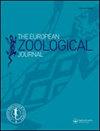Diaphanosoma(Diplostraca:Sididae)属在中欧的分布——形态学和分子方法
IF 1.6
4区 生物学
Q2 ZOOLOGY
引用次数: 1
摘要
摘要短鳍双体是中欧夏季浮游动物的主要组成部分。到目前为止,在波兰只发现了这个物种,在邻国也发现了该属的其他物种。本研究的目的是介绍Diaphanosoma物种在中欧的实际分布。我们通过形态学分析和分子方法(mtDNA COI基因)相结合,对中欧109个水体(主要来自波兰)中的染色体体个体进行了调查。我们的研究证实了另外三个物种的存在——奥氏D.orghidani、蒙古D.mongolianum和冰湖D.cf。我们为每个物种提供了详细的形态学描述,并指出每个物种都可以通过后腹侧瓣膜边缘的武装在形态学上很容易地区分。基于27个mtDNA COI基因单倍型的系统发育分析结果得出了与形态学相同的结论。我们的遗传和形态学分析证实了沙鼠和湖鼠之间的密切亲缘关系,以及这些物种之间存在杂交种。然而,最常见的是D.brachyurum——它在97个水体中被发现,其他Diaphanosoma物种开始通过河流进入中欧。本文章由计算机程序翻译,如有差异,请以英文原文为准。
Distribution of Diaphanosoma (Diplostraca: Sididae) genus in Central Europe – morphological and molecular approach
Abstract Diaphanosoma brachyurum is a dominant component of summer zooplankton in Central Europe. So far only this species has been known from Poland, and other species from this genus have been found in neighboring countries. The aim of the present study was to present the factual distribution of Diaphanosoma species in Central Europe. We investigated Diaphanosoma individuals in 109 water bodies in Central Europe (mostly from Poland) by combining morphological analyses and molecular methods (mtDNA COI gene). Our research confirmed the presence of three other species - D. orghidani, D. mongolianum, and D. cf. lacustris. We provided a detailed morphological description for every species and pointed out that each species can be easily distinguished morphologically by armament of postero-ventral valve margins. The results of phylogenetic analysis based on 27 haplotypes of mtDNA COI gene lead to the same conclusion as morphology. Our genetic and morphological analysis confirms a close affinity between D. mongolianum and D. lacustris, as well as the presence of hybrids between these species. Nevertheless, the most common was D. brachyurum - it was found in 97 water bodies, and other Diaphanosoma species begin to penetrate Central Europe via rivers.
求助全文
通过发布文献求助,成功后即可免费获取论文全文。
去求助
来源期刊

European Zoological Journal
Agricultural and Biological Sciences-Animal Science and Zoology
CiteScore
3.10
自引率
5.60%
发文量
80
审稿时长
30 weeks
期刊介绍:
The European Zoological Journal (previously Italian Journal of Zoology) is an open access journal devoted to the study of all aspects of basic, comparative and applied protozoan and animal biology at molecular, cellular, tissue, organ, organismal, population, and community-ecosystem level. Papers covering multiple levels of organization and integrative approaches to study animal form, function, development, ecology, evolution and systematics are welcome. First established in 1930 under the name of Il Bollettino di Zoologia, the journal now has an international focus, reflected through its global editorial board, and wide author and readership.
 求助内容:
求助内容: 应助结果提醒方式:
应助结果提醒方式:


